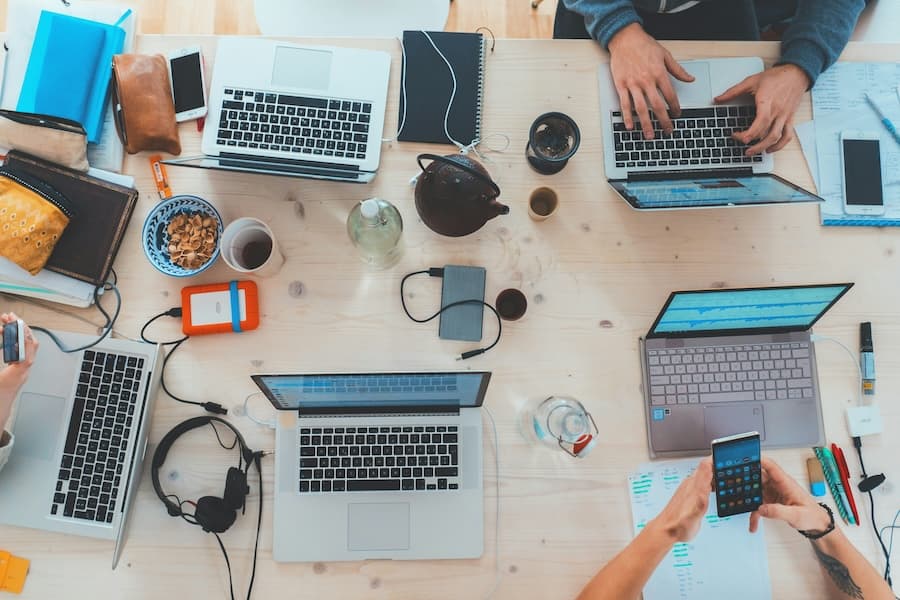One Change for a Surge in Employee Productivity – Have You Tried It?
Employee Productivity
In the rapidly evolving landscape of the modern workplace, the significance of employee productivity cannot be overstated. As businesses grapple with technological advancements and changing work dynamics, the productivity of their workforce emerges as a cornerstone of sustainable growth. The ability to increase employee productivity not only ensures that businesses remain competitive but also that they can adapt to the challenges of the future.
With the rise of remote work, flexible hours, and a globalized workforce, the traditional metrics to measure and improve productivity have evolved. Now, more than ever, businesses need to focus on creating an optimal work environment that fosters innovation, collaboration, and efficiency.
ProofHub’s Tips on Team Productivity suggests that a harmonious team environment can significantly improve productivity. But what exactly is employee productivity, and why is it so crucial?
What Is Employee Productivity?
Employee productivity is a measure of the efficiency of a worker. It’s calculated based on the amount of output produced on a specific task relative to the amount of time and resources invested in that task. In simpler terms, it’s about doing more with less.
The significance of productivity extends beyond mere numbers. It reflects the health of an organization, the effectiveness of its strategies, and the satisfaction of its employees. A productive work environment is often synonymous with high employee engagement, job satisfaction, and overall business success.
Central to this concept is the role of motivation. When employees are motivated, they are more likely to:
- Put in extra effort in their tasks.pridu
- Seek innovative solutions to problems.
- Collaborate effectively with team members.
- Stay committed to the company’s goals.
Factors Affecting Employee Productivity in the Workplace
Several factors can influence employee productivity. Understanding these can help businesses implement strategies to improve employee productivity. Some of the main factors include:
- Workload Balance: Striking the right balance between too much and too little work is crucial. Overburdening employees can lead to burnout, while underutilizing them can result in boredom and disengagement.
- Team Dynamics and Conflicts: Positive team dynamics can boost productivity, while unresolved conflicts can hamper it. Effective communication, mutual respect, and clear role definitions are essential for harmonious team interactions.
- Low Morale and Motivation: Often referred to as the ‘silent killer’ in the workplace, low morale can drastically reduce productivity levels. Factors like lack of recognition, inadequate compensation, and lack of growth opportunities can contribute to decreased motivation.
The Importance of Employee Productivity
Employee productivity is not just a metric; it’s a reflection of a company’s health. High productivity levels indicate:
- Efficient processes and strategies.
- High employee engagement and satisfaction.
- A positive and conducive work environment.
Every employee contributes to a company’s success. Whether it’s through direct output, innovative ideas, or collaborative efforts, each employee adds value. Therefore, maximizing employee experience and ensuring that they have the tools, training, and motivation to perform at their best is paramount.
Management plays a pivotal role here. Leaders and managers need to:
- Set clear expectations and goals.
- Provide regular feedback and recognition.
- Foster a culture of continuous learning and improvement.
Identifying Causes of Low Productivity Workplace
Recognizing and addressing the causes of low productivity is the first step towards improving it. Some common signs of decreasing productivity include:
- Declining quality of work.
- Increased absenteeism.
- Low morale and lack of enthusiasm.
To address these issues, businesses can:
- Address Workload Issues: Regularly review and adjust workloads to ensure they are manageable and aligned with employees’ skills and capacities.
- Resolve Team Conflicts: Promote open communication, provide conflict resolution training, and intervene when necessary to resolve disputes.
- Boost Team Motivation: Implement recognition programs, provide growth opportunities, and ensure that employees feel valued and appreciated.
By understanding and addressing the root causes of low productivity, businesses can create a positive work environment that promotes efficiency, innovation, and growth.
Top 10 Tips to Increase Employee Productivity
In today’s dynamic business landscape, the need to boost productivity is paramount. With the rise of remote work and flexible schedules, businesses are constantly seeking ways to increase employee productivity. Here are the top ten strategies that can significantly impact employee productivity in the workplace:
1: Improve Employee Onboarding
A well-structured onboarding process is more than just a formality; it’s the foundation for long-term employee productivity and retention. When new hires are given comprehensive training, resources, and mentorship from the start, they can quickly adapt to the company’s culture, tools, and processes. This not only reduces the time they spend adjusting but also boosts their confidence and motivation.
By effectively measuring employee productivity during the onboarding phase, businesses can identify areas of improvement, tailor training programs, and set clear expectations. This proactive approach ensures that every new team member contributes positively to the workplace productivity, fostering a harmonious and productive work environment.
2: Stop Micromanaging
Every individual employee brings a unique set of skills and perspectives to the table. By trusting them and providing them with the autonomy to make decisions, businesses can unlock their full potential. Micromanaging, on the other hand, can be counterproductive. It not only hampers creativity but also leads to increased stress and burnout.
When employees feel trusted and valued, they are more likely to take initiatives, think out of the box, and drive innovation. This sense of ownership and responsibility can significantly boost employee productivity. Leaders should focus on providing guidance, resources, and support rather than controlling every aspect of the work process.
3: Encourage Flexible Working and Time Off
The traditional 9-to-5 work model is evolving. With advancements in technology and changing societal norms, flexible working hours and remote work have become increasingly popular. Recognizing and adapting to this change can have profound benefits for businesses. Employees who have the flexibility to choose their working hours or work from the comfort of their homes often report higher levels of satisfaction, reduced stress, and better work-life balance. This, in turn, leads to increased motivation, reduced absenteeism, and higher productivity.
Moreover, providing regular time off and encouraging breaks can rejuvenate employees, preventing burnout and ensuring consistent performance. Businesses that leverage the right tools and software can easily manage and measure productivity in such flexible setups, ensuring that the productivity formula remains effective regardless of where or when the work is done.
4: Hire for Culture Fit, Not Just Skills
In the modern workplace, hiring decisions based solely on skills can be shortsighted. While technical expertise is essential, an employee’s alignment with the company’s culture, values, and mission is equally crucial. Employees who resonate with the company’s ethos tend to be more motivated, loyal, and engaged.
Their commitment goes beyond their job descriptions, leading to increased creativity, collaboration, and innovation. Such alignment fosters a sense of belonging, reducing turnover rates and promoting long-term growth. In essence, when an employee’s productivity is rooted in a genuine belief in the company’s vision, the results are more sustainable and impactful.
5: Encourage Team Collaboration
The power of collective intelligence cannot be overstated. When diverse minds come together, the potential for innovation multiplies. Fostering a culture where team members freely share ideas, knowledge, and resources can significantly elevate the team’s productivity.
Modern collaboration tools and productivity software make it easier for teams to communicate, brainstorm, and execute projects seamlessly, irrespective of geographical boundaries. Such a collaborative environment not only leads to better solutions but also builds trust, mutual respect, and a sense of community, further enhancing workplace productivity.
6: Champion Clear Communication
In any organization, clear communication is the backbone of efficiency. Misunderstandings, ambiguities, and lack of clarity can lead to errors, delays, and decreased morale. By championing open communication channels, leaders can ensure that expectations are set, feedback is provided, and concerns are addressed promptly.
Regular team meetings, one-on-one sessions, and open-door policies can foster an environment where every voice is heard. When everyone is on the same page, projects move forward smoothly, goals are achieved faster, and the overall productivity in the workplace sees a marked improvement.
7: Focus on Comprehensive Employee Training
The business landscape is constantly evolving, with new technologies, methodologies, and best practices emerging regularly. To stay competitive and ensure consistent growth, businesses must invest in comprehensive employee training. Regular workshops, seminars, and courses ensure that the workforce is equipped with the latest knowledge and skills.
This not only enhances their individual capabilities but also ensures that the company stays ahead of the curve. An employee who is confident in their skills and knowledge is more likely to take initiatives, solve complex problems, and contribute positively to the company’s goals, leading to a significant boost in employee productivity.
8: Actively Seek Feedback
In the continuous journey of organizational growth, feedback serves as the compass. By actively seeking feedback from employees at all levels, organizations can gain insights into what’s working and what’s not. This feedback can range from operational processes to workplace culture. Addressing the identified areas not only streamlines processes but also fosters a culture of continuous improvement.
Moreover, when employees see that their feedback is valued and acted upon, it instills a sense of ownership and belonging. This proactive approach not only enhances employee productivity but also aids in refining and tailoring productivity measures to better align with the company’s goals.
9: Recognize and Appreciate Efforts
In the hustle and bustle of daily operations, the power of simple recognition can often be overlooked. However, acknowledging and appreciating the efforts of employees can have profound effects on their morale and motivation. When employees feel that their hard work is noticed and valued, they are more likely to go the extra mile.
Recognizing the quality and timeliness of the work an employee delivers can set a benchmark for others, fostering a competitive yet collaborative environment. Such recognition doesn’t always have to be grand; even simple gestures like a thank-you note or a shout-out in team meetings can significantly boost employee morale and, in turn, productivity levels.
10: Value Transparency in Delegating Tasks
Delegation is an art, and transparency is its cornerstone. When tasks are delegated with clear expectations, timelines, and objectives, it eliminates ambiguity and sets the stage for efficiency. Employees, when equipped with all the necessary information, can better plan, prioritize, and execute their tasks.
Furthermore, transparency in delegation allows for better tracking and measurement of progress. By measuring productivity by taking into account the clarity of instructions and the subsequent execution, organizations can identify bottlenecks, areas of improvement, and best practices. This not only ensures that tasks are completed efficiently but also empowers employees, enhancing their confidence and capability to tackle challenges.
1800 Office Solutions on Employee Efficiency suggests that these strategies, when implemented correctly, can lead to tangible improvements in employee productivity. Proper implementation can ensure that employee productivity in the workplace remains consistent and continues to grow.
Providing the Right Tools to Improve Employee Productivity
In the digital age, leveraging the right tools can significantly boost employee productivity. Here are some tools and their benefits:
- Company Intranets: These platforms facilitate internal communication, document sharing, and collaboration, enhancing workplace productivity.
- Mobile Apps for Accessibility: Mobile applications ensure that employees can access work-related resources anytime, anywhere, promoting flexibility and productivity in the workplace.
- Curated Content: Providing employees with curated content relevant to their roles can enhance their knowledge and skills.
- Surveys for Actionable Feedback: Surveys can gather employee feedback, which can be used to make informed decisions to boost productivity.
- Employee Recognition Software: Such software can automate the process of recognizing and rewarding employees, leading to increased motivation and productivity.
Methods to Measure Employee Productivity
Productivity measurement is crucial for businesses to gauge the effectiveness of their strategies. Here are some methods:
- Setting and Measuring Goals: Clearly defined goals provide a direction, and measuring progress towards these goals can give insights into employee performance.
- Evaluating Quality and Quantity of Work: This involves assessing the output of an employee in terms of both quality and quantity.
- Time Management and Efficiency: Analyzing how effectively employees manage their time can provide insights into their productivity.
What People Also Ask
What factors affect employee productivity?
Several factors can impact employee productivity, including work environment, management practices, workload balance, team dynamics, and individual employee motivation.
How can businesses measure employee productivity?
Businesses can measure productivity by taking into account the output versus the input, setting clear goals, evaluating the quality and quantity of work, and assessing time management skills.
Why is focusing on improving employee productivity important?
Focusing on employee productivity is vital as it directly impacts business growth, profitability, and sustainability. A productive workforce can achieve business goals more efficiently.
How does remote work impact employee productivity?
Remote work can have both positive and negative impacts on employee productivity. While it offers flexibility, it also requires self-discipline. With the right tools and management practices, remote work can lead to increased productivity.
Conclusion
Employee productivity stands as a pivotal element in the blueprint of a company’s success. In today’s rapidly changing business world, it’s more crucial than ever for organizations to be agile, adapting and seeking innovative strategies to amplify productivity.
By meticulously implementing the right approaches, fostering a nurturing and positive work environment, and harnessing the power of the latest tools and technologies, businesses can not only elevate their operational efficiency but also cultivate a motivated workforce.
This harmonious blend of strategy, environment, and technology paves the way for businesses to thrive, ensuring robust growth, enhanced competitiveness, and long-term success in their respective domains.












